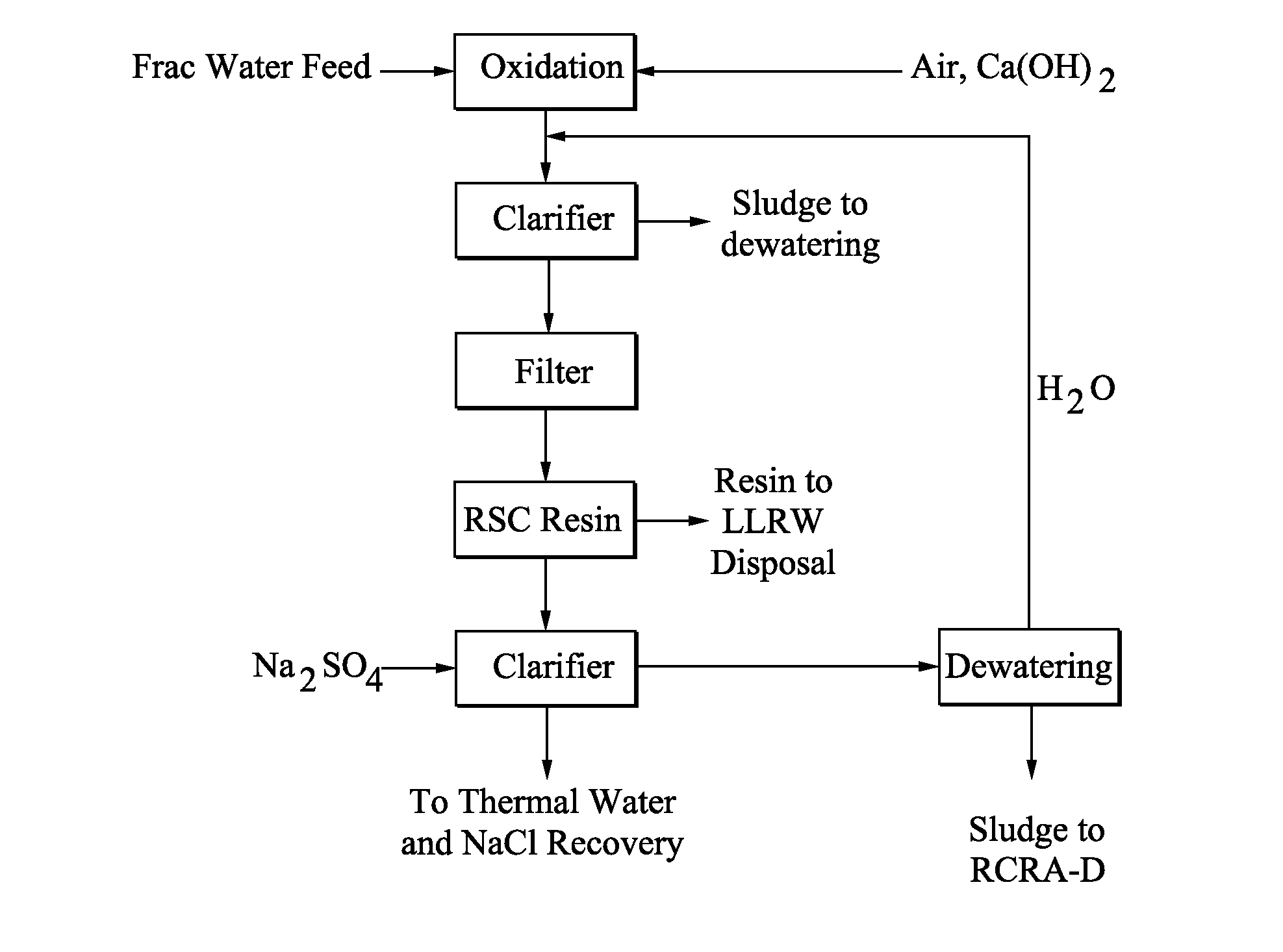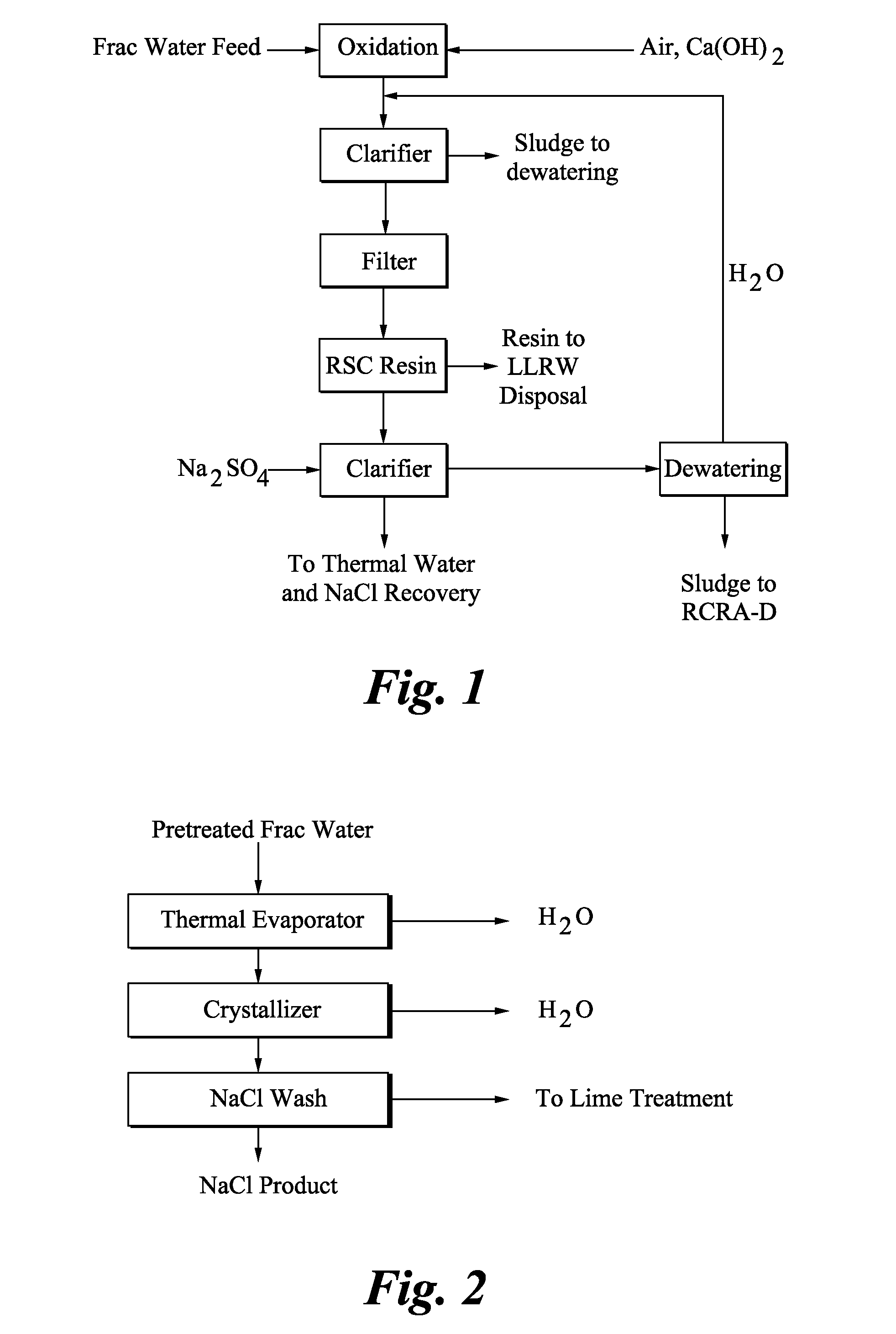Norm removal from frac water
a technology of frac water and frac water, which is applied in the direction of multi-stage water/sewage treatment, separation process, borehole/well accessories, etc., can solve the problems of discharge to rivers and other surface waters, few available deep well injection sites, and inability to dispose of surface waters
- Summary
- Abstract
- Description
- Claims
- Application Information
AI Technical Summary
Problems solved by technology
Method used
Image
Examples
example 1
[0027]Samples of 18 gm brine (E-1) were mixed with various amounts of DOWEX RSC resin to establish a radium adsorption isotherm. Brine and resin were added to centrifuge tubes and placed on a rotary laboratory mixer for 24 hours at 10 rpm. The samples were then decanted and measured for radioactivity by liquid scintillation counting.
[0028]Radium has many short-lived daughter products (e.g. radon gas, polonium, lead, and bismuth). These daughter products are not ion exchanged onto RSC resin. When the daughter products decompose, they register along with radium in the liquid scintillation counter. Therefore, with RSC treatment, it is not possible to reduce the liquid scintillation count measurement down to the background level. Instead, we have found that the counts reach a plateau as the proportion of RSC resin to brine increases. We take the plateau count level as being indicative of substantially radium-free brine. We then estimate the total activity based on an assumed counting ef...
example 2
[0031]E-1 brine was spiked with 1000 ppm Ba (as BaCl2) and the isotherm was measured as shown in Table 3.
TABLE 3Liquid Scintillation Counting Results: Brine Spike-1RemovableSample-TotalActivityConc onBlankActivityin solutionResinSampleResin (g)Brine (g)Count / minCount / min(pCi / L)(pCi / L)(pCi / g)Blank32.150Spike-1-101850.3818.2391245277Spike-1-20.09118.239849.0716.9284684622113Spike-1-30.19817.9348.416.258133428677Spike-1-40.397317.8946.7514.67307346071Spike-1-50.620718.0846.814.657332348545Spike-1-60.787417.98945.1212.976491264552Spike-1-70.252317.8650.6518.592595412−8
This example shows that the resin capacity for radium decreased significantly to about 110 pCi / gm in the presence of about 1,000 ppm barium.
example 3
[0032]E-1 brine was spiked with 11,600 ppm Ba (as BaCl2) and the isotherm was measured as shown in Table 4. This example shows that the resin capacity for radium decreased even more significantly to about 70 pCi / L in the presence of 11,600 ppm barium.
TABLE 4Liquid Scintillation Counting Results: Brine Spike-2RemovableSample-TotalActivityConc onBlankActivityin solutionResinSampleResin (g)Brine (g)Count / minCount / min(pCi / L)(pCi / L)(pCi / g)Blank34.20Spike-2-1018.15892.5841.4103723414Spike-2-20.10318.11788.5239.69917295969Spike-2-30.19618.09186.8838.89733277651Spike-2-40.39518.01687.939.39848289021Spike-2-50.60118.13682.7537.09271231329Spike-2-60.78918.14177.4834.68680172234Spike-2-70.20218.04487.8739.39844288641
PUM
 Login to View More
Login to View More Abstract
Description
Claims
Application Information
 Login to View More
Login to View More - R&D
- Intellectual Property
- Life Sciences
- Materials
- Tech Scout
- Unparalleled Data Quality
- Higher Quality Content
- 60% Fewer Hallucinations
Browse by: Latest US Patents, China's latest patents, Technical Efficacy Thesaurus, Application Domain, Technology Topic, Popular Technical Reports.
© 2025 PatSnap. All rights reserved.Legal|Privacy policy|Modern Slavery Act Transparency Statement|Sitemap|About US| Contact US: help@patsnap.com



